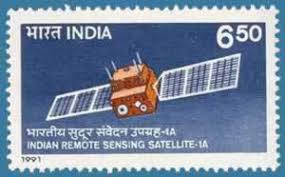 On 17 March 1988, the first indigenous remote sensing satellite developed by the Indian Space Research Organization (ISRO), the IRS-1A was launched by a Soviet launch vehicle Vostok.
On 17 March 1988, the first indigenous remote sensing satellite developed by the Indian Space Research Organization (ISRO), the IRS-1A was launched by a Soviet launch vehicle Vostok.
Get the list of Indian Satellites from the linked article.
Related links:
| Difference between Planet and Satellite | Satellite Launch Vehicle Program |
| EOS-O1 Satellite | Queqiao Satellite |
| Cartosat-3 | Cartosat-2 |
IRS-IA
- The Indian Remote Sensing Satellite-1A or the IRS-1A was launched on March 17th, 1988 from a Soviet cosmodrome, the Baikonur Cosmodrome currently in Kazakhstan. It was launched at about 12:00 AM Indian Standard Time.
- The satellite was the first Indian-made remote sensing satellite developed by the Indian Space Research Organisation (ISRO).
- The launch vehicle was a Russian Vostok. It was launched into a sun-synchronous polar orbit.
- The satellite’s mission was operational remote sensing and was to be used for land-based applications in areas like agriculture, geology, forestry and hydrology.
- It had a swath width of 140 km while passing over the country.
- The total weight of the satellite was 975 kg. Its payload consisted of three solid-state push-broom cameras, LISS-1 with a resolution of 72.5 m; LISS-2A; and LISS-2B with a resolution of 36.25 m. LISS stands for Linear Imaging Self-Scanning System. The onboard power was 600 Watts.
- The push-broom sensors operated over the spectral bands: 0.45-0.52, 0.52-0.59, 0.62-0.68, and 0.77-0.86 micrometre.
- Its orbit was 904 km above the earth. The orbit inclination was 99.01 degrees with a repeat cycle of 22 days.
- It had a perigee of 863 km and an apogee of 917 km.
- IRS-1A was an earth observation satellite developed and owned by ISRO.
- The satellite’s communication parameters were S-band, X-band and VHF.
- It had four reaction wheels.
- It used monopropellant Hydrazine with sixteen 1 Newton thrusters for propellants.
- Local passing time over the equator was fixed at about 10:00 AM.
- The mission was completed in July 1996 after eight years and four months.
See previous ‘This Day in History’ in the linked article.
| Aspirants can cover the topics mentioned in the UPSC Syllabus by following the below-mentioned links: |
Also on this day
1959: The Dalai Lama escaped to India from Tibet.
UPSC Preparation:
Comments